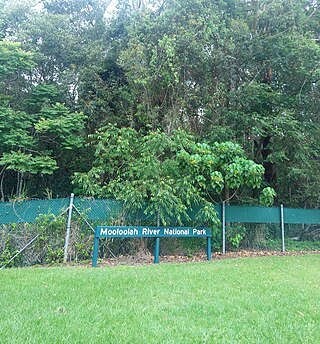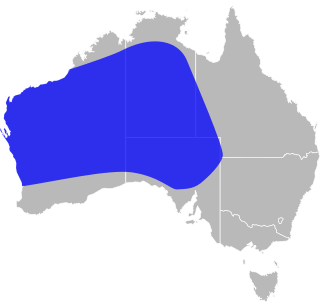
Brisbane Water National Park is a national park on the Central Coast of New South Wales, Australia. The national park is situated 70 kilometres (43 mi) north of Sydney and 12 kilometres (7.5 mi) southwest of Gosford. It consists the Brisbane Water and Mooney Mooney Creek waterways.

The Mooloolah River National Park is a nationally protected area located on the Sunshine Coast, Queensland. It covers an area of 830.9 hectares and is bordered by the Mooloolah River to the east, Claymore and Dixon Roads to the west, and the Lower Mooloolah River Environmental Reserve to the south. It is bisected by the Sunshine Motorway with the northern, 161.93 hectare component of the Park being a later addition. The Park was initially vacant crown land prior to national park designation in 1960. Surrounding land uses include livestock grazing, urban development and the campus of the University of the Sunshine Coast. It is the second largest mainland park on the coastal lowlands in South East Queensland after Noosa National Park and represents an example of low-lying coastal floodplain distinctive of the region.

The ringed kingfisher is a large, conspicuous, and noisy kingfisher bird commonly found along the lower Rio Grande Valley in southeasternmost Texas in the United States through Central America to Tierra del Fuego in South America.

The black-breasted buttonquail is a rare buttonquail endemic to eastern Australia. As with other buttonquails, it is unrelated to the true quails. The black-breasted buttonquail is a plump quail-shaped bird 17–19 cm (6.7–7.5 in) in length with predominantly marbled black, rufous, and pale brown plumage, marked prominently with white spots and stripes, and white eyes. Like other buttonquails, the female is larger and more boldly coloured than the male, with a distinctive black head and neck sprinkled with fine white markings. The usual sex roles are reversed, as the female mates with multiple male partners and leaves them to incubate the eggs.

The chocolate wattled bat is a bat in the family Vespertilionidae. It is found only in Australia, including the island Tasmania, and widespread in southern regions. It is known to reside from sea level to at least 1,570 metres (5,150 ft) in Victoria.

The Visayan broadbill is a species of bird in the family Eurylaimidae where it was previously conspecific with the wattled broadbill. It is endemic to the islands of Samar, Leyte and Bohol in the central Philippines. Its natural habitat is tropical moist lowland forests. It is threatened by habitat loss.

The striped legless lizard is a species of lizards in the Pygopodidae family endemic to Australia. As of 2015 it is threatened with extinction, with few habitats left.

The Brigalow scaly-foot, also known as the Queensland snake-lizard, is a species of legless lizard in the family Pygopodidae. It is endemic to Australia and is the only species in the monotypic genus Paradelma.
Scottsdale Reserve is a 1,328-hectare (3,280-acre) nature reserve on the Murrumbidgee River in south-central New South Wales, Australia. It is 79 kilometres (49 mi) south of Canberra, and 4 kilometres (2.5 mi) north of Bredbo. It is owned and managed by Bush Heritage Australia (BHA), which purchased it in 2006. The purchase was supportive of projects aiming to connect existing fragmented remnant habitat such as K2C. Since the 1870s up until 2006, the land was used for agriculture – primarily sheep grazing with some minor cropping. A significant component of the Reserve has been cleared of native vegetation.

Burton's legless lizard is a species of lizard in the family Pygopodidae. The species lacks forelegs and has only rudimentary hind legs. Pygopodid lizards are also referred to as "legless lizards", "flap-footed lizards" and "snake-lizards". This species is native to Australia and Papua New Guinea.

The hooded scaly-foot, also known as western scaly-foot, black-headed scaly-foot or western hooded scaly-foot, is an endemic Australian legless lizard of the family Pygopodidae.

Lucasium stenodactylum, also known as the crowned gecko or pale-snouted ground gecko, is a species of gecko from Australia.
The eastern hooded scaly-foot or eastern scaly-foot is a species of flap-footed lizard found in the complex heaths of the lower west coast and the spinifex grasslands of mainland Australia. They are popular pets and are often mistaken for snakes due to their limbless appearance.
The soil-crack whip snake or crack-dwelling whipsnake is a species of venomous snake in the family Elapidae. It is only mildly venomous.

The Delma australis is often known as the southern legless lizard, or the marble-faced delma. This terrestrial lizard falls into the category of slender Pygopodidae, a legless lizard. There are 21 known species in the Pygopdidae family in Australia. Marble-faced delmas are endemic to Australia. Delma australis was first described by Kluge in 1974.

The excitable delma is a species of lizard in the Pygopodidae family endemic to Australia. The lizard gets its name from its active and jumpy defense mechanism. It will erratically jump multiple times in succession, each jump pivoting its body in a different direction. D. tincta is a slender, long legless lizard that through evolution lost its limbs. It is found throughout Australia in a variety of habitats, and spends most of its time hiding. Due to its nocturnal nature, it is rare to spot in the wild. This legless lizard is small to moderate in size, with a tail that is three to four times its body length. The typical size of the excitable delma is 250 – 300 mm. This lizard is an insectivore and feeds on insects it finds when travelling through grass, logs, surface soil, and loose rocks. Like all pygopodids, the excitable delma is oviparous and only lays two eggs per clutch.

The Mallee worm-lizard , also known as the pink-nosed worm-lizard and the red-tailed worm-lizard, is a slender pygopid species that is endemic to Australia, with recorded distribution across the four southern mainland states, although its distribution is restricted in Western Australia and New South Wales.
The Gnaraloo worm-lizard is a species of legless lizard in the family Pygopodidae and order Gekkota. The Gnaraloo worm-lizard is a small, slim worm-lizard, with a snout–vent length between 60 and 98 cm, with an average of 84.8 cm (33.4 in), and a mean tail length of 60.7 cm (23.9 in). The upper side of the body is yellowish-brown, the sides are silvery-grey, and the underside of the body and head is heavily marked with dark brown flecks. The underside of the tail is light yellow; regenerated parts of the tail are greyish and marked with dark brown.
Delma vescolineata, commonly known as the Hunter Valley Delma, is a species of legless gecko from the Pygopodidae family.

The olive legless lizard is a species of legless gecko from the Pygopodidae family. This species is commonly found throughout the Australian Capital Territory, New South Wales, Queensland, Victoria and southeastern South Australia, mostly inhabiting areas consisting of dry to temperate southern grasslands and grassy woodlands.

















